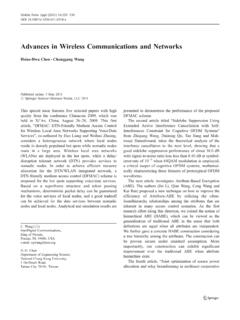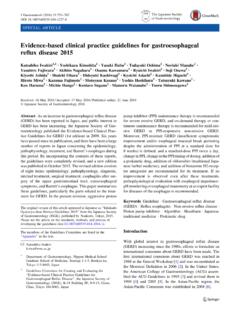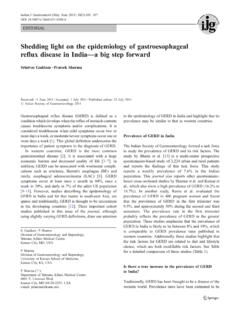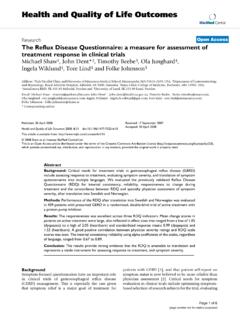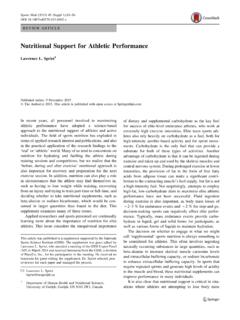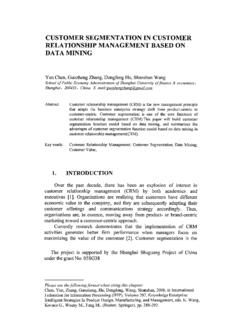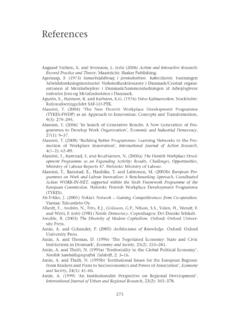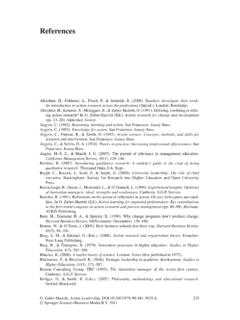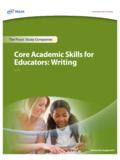Transcription of Glossary of Qualitative Research Terms
1 306 Glossary of Qualitative Research TermsThe definitions in this Glossary define key words commonly used in Qualitative and mixed methods Research . Throughout the book, these key words are indicated in bold when they are particularly relevant to the topic of the chapter, and are also listed at the end of that words are listed alphabetically. In the definitions, words in italics are also listed in the Glossary . The chapter in which the key word is primarily addressed is noted in parentheses at the end of each definition; however, many of the Terms can be found in additional chapters as well; please refer to the subject index for WordDefinitionaccountsIn an interview, an account is a representation of a situation. Successful analysis depends on treating what the participants say as subjective accounts that the researcher must interpret, rather than factual reports than can be simply accepted at face value.
2 (Interviews, p. 192)actingActing refers to the second step in the action Research cycle. Acting means putting practical strategies in place to change and improve a teaching or social situation; the next step is observing these changes. (Action Research , p. 115)action researchAction Research is a Research approach. Action refers to the process of identifying issues relevant to a teaching or social situation; Research refers to the processes of systematically collecting, documenting, and analyzing data. Data can be numerical as well as textual. In the field of applied linguistics, action Research is often used by teachers when they investigate their own classrooms. (Action Research , p. 114)action Research cycleThe action Research cycle is the process or spiral of Research in action Research . It involves four steps: planning, acting, observing, and ref lecting. (Action Research , p. 115)adjacency pairsIn discourse analysis, adjacency pairs are paired utterances such as question-answer and compliment-response.
3 The nature of the first-pair-part (for example, how the question is asked) conditions the structure of the second-pair-part (for example, how the question is answered). (Discourse Analysis, p. 250) Glossary of Qualitative Research Terms 307 Key WordDefinitionanalytic memosAnalytic memos are personal notes (including ideas, questions, hunches, and speculations) a researcher makes during the Research process about the collected data, and includes the researcher s ideas and interpretations. (Ethnography, p. 102)annotated bibliographyAnnotated bibliographies are summaries and brief commentaries of individual published works. (Writing Up Your Research , p. 291)applied linguistics Applied linguistics is the study of language in use. It can be divided into two broad areas. The first focuses primarily on language itself, and is called language analysis. The second investigates the contexts and experiences of language use. Both areas employ Qualitative , quantitative, and mixed Research methods.
4 (Introduction, p. 4)artifacts(also artefacts)Artifacts are things that people within a cultural group make and/or use. (Ethnography, p. 93)autoethnographyAn autoethnography is a study of the self over a long period of time. (Writing Up Your Research , p. 294)axiologyAxiology is the study of value. In Qualitative Research , there is an assumption that all Research is value-laden, and includes the value systems of the researcher, the theory, Research methodology, and Research paradigm, as well as the social and cultural norms of the researcher and ethnography, behavior refers to what people within a cultural group do and the acts that they perform. (Ethnography, p. 93)biased questionsBiased questions are questionnaire items that put one group of people in a bad light based on gender, religion, ethnicity, and so on. (Open-Response Items in Questionnaires, p. 208)boundednessBoundedness is a term used in case study to refer to the parameters of a case.
5 These could include the individual or entity, for example a school, under investigation and the settings in which social action takes place. (Case Study, p. 68)case studyCase study is a Research approach. It creates an in-depth description and analysis of a bounded system one individual, institution, or educational context. By concentrating on a single (or few) case(s), this approach can describe a particular learning or teaching process or Research setting in great detail. The focus of a case study can either be on the case itself or on an issue which the case(s) illustrates. Case study uses multiple sources of data and data collection methods, and it often combines both Qualitative and quantitative Research approaches. (Case Study, p. 68) categorical content analysisCategorical content analysis is a method of data analysis that identifies categories by selecting utterances from a text, which are then classified and grouped together.
6 (Narrative Inquiry, p. 51)categoryResearchers create a category in the data analysis process by grouping together related codes, either as examples or components of a particular concept. (Narrative Inquiry, p. 52)308 Glossary of Qualitative Research TermsKey WordDefinitioncitingCiting means referring to the work of an author by name (and usually by year of publication, depending on stylistic conventions) in the body of a Research report. (Writing Up Your Research , p. 291)claimA claim is a new understanding or finding in Research . It is a term that tries to capture both what the researcher feels definite about stating and the gaps or limitations in this new knowledge. (What Makes Research Qualitative ?, p. 26)closed-response itemsClosed-response items are questionnaire items in which participants select from a limited list of options provided by the researcher by circling them, making an X and so on; participants are not requested to respond in their own words.
7 (Open-Response Items in Questionnaires, p. 201)closingIn discourse analysis, closing is the action which shuts down an interaction. It is composed of at least one adjacency pair, such as see you later bye . (Discourse Analysis, p. 243)co-constructionCo-construction is the idea in discourse analysis that language use is a product not just of its speaker but also those who are interacting with that speaker. (Discourse Analysis, p. 245)codingCoding is one aspect of data analysis. When researchers code, they are trying to make sense of the data by systematically looking through it, clustering or grouping together similar ideas, phenomena, people, or events, and labeling them. Coding helps researchers find similar patterns and connections across the data. It helps researchers get to know the data better and to organize their thinking, and it also makes storage and retrieval of data easier. (Narrative Inquiry, p. 51)coding systemA coding system is created during data analysis.
8 It is a list of the labels of the categories created when the researcher is coding. Frequently these labels are derived from the data itself (in which case they are called emic Terms ), but often they are Terms created by the researcher (in which case they are called etic Terms ). In verbal reports, these labels attempt to capture the intentions of all of the thought units mentioned by the participants. (Introspective Techniques, p. 224)collective case studyIn a collective case study the researcher uses more than one case, so as to better shed light on a particular issue. A collective case study often focuses on exploring an issue rather than describing one case in detail, by comparing and contrasting different cases. (Case Study, p. 70)concordancing softwareConcordancing software is software that lists occurrences of any word or phrase from a given text, along with a certain number of words on either side of it. (Open-Response Items in Questionnaires, p.)
9 211) Glossary of Qualitative Research Terms 309 Key WordDefinitionconfirmabilityConfirmabili ty is the concept that researchers should fully explain or disclose the data that they are basing their interpretations on, or at least make those data available. Confirmability can be improved by maintaining precise data records and keeping all data for additional scrutiny. (Open-Response Items in Questionnaires, p. 215)consequentialismConsequentialism is the belief that ends justify means; that is, that the results of actions determine their rightness or wrongness. Any particular action is neither intrinsically good nor bad; rather, it is good or bad because of its results in a particular context its consequences. (Ethics and Trustworthiness, p. 270)constant comparative methodThe constant comparative method is a method of data analysis from grounded theory in which the researcher constantly compares new data to data already placed in existing categories, to help develop and define that category and decide if a new category should be created.
10 (Narrative Inquiry, p. 51)constructivismConstructivism is the belief that that there is no universally agreed upon reality or universal truth . Rather, meaning is socially constructed by individuals interacting with their world. Through that interaction, each individual creates his or her own unique understandings of the world. As a result, there are multiple constructions and interpretations of reality, so multiple truths exist. These interpretations change, depending upon time and circumstances, so reality is not universal but person-, context-, and time-bound. (Introduction, p. 6)contextContext refers to the physical, psychological, social, and/or temporal factors of authentic language in use. (Discourse Analysis, p. 243)conventionsConventions are customary stylistic choices in writing that scholars within disciplines agree upon as a group to use, such as ways of citing sources and formatting a reference list. (Writing Up Your Research , p.)

